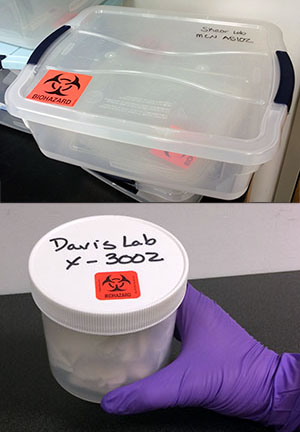Please note that this information only applies to on campus hand or cart transportation of biological materials. If you need to transport biological materials on public roads, you must comply with US Department of Transportation regulations. Refer to Biosafety Training for more information about shipping biological substances.
print version of this document
Almost all life science-related research teams will need to transport biological materials between lab areas in support of their lab analyses. Common examples include cell cultures, viral vectors, body fluid and tissue specimens and infectious agents. Containment procedures are used in the lab to protect personnel from unnecessary contact with these materials. When they are transported from one lab location to another, it is important to apply the same containment principles in order to minimize the potential for a release of these materials while en route:
- Store biological research materials in a primary container that is designed for the type of material contained within, and securely close the container.
- Place primary containers in a hard-walled secondary container constructed of materials that can be effectively cleaned and disinfected.
- If the materials need to be transported on dry ice, enclose the styrofoam container in a secondary container that is twice the size of the liner to allow sufficient expansion space for the dry ice during transport. (Assure that the lid is loosened when you reach your destination!)
- Securely close the secondary container in such a way that if it were dropped, the container will not come open (screw tops, latch lids, or other positive means of closure are recommended).
- If the materials need to be transported on wet ice, assure that the container meets the criteria for a secondary container as described above. Otherwise, place the ice container within another container that does meet the criteria.
- If the primaries (not requiring dry ice or wet ice) are breakable, and/or contain sufficient liquid content to create a puddle, separate the primaries with absorbent cushioning materials.
-
If the secondary container is used to transport materials requiring BSL-2 containment or higher, label the container with the biohazard symbol and lab identification information. (See picture to right for example of a secondary container labeled for transporting such materials.)

Examples of Biological Sample Secondary Containers
- If more materials need to be moved than can be effectively carried in one hand, use a cart. Remember: Do not touch common contact surfaces in public areas with gloved hands! If you wear gloves for handling the secondary container, you must have one hand ungloved for touching door knobs, elevator buttons and other common contact surfaces while en route.
- When transporting biological materials avoid traveling through areas where food is served or consumed. Also avoid transport routes through stairwells, carpeted areas, high traffic public areas, and outdoor areas.
- Be prepared to contact OCRS (322-2057 or 835-4965) if a spill occurs during transport in a public area. Carry a charged cell phone and have these numbers programmed. If a spill does occur, stay with the spill and divert others away from the area until help arrives.
If you need to transport biological research materials locally, but off-campus, please contact OCRS Biosafety (615-322-2057 or biosafety@vumc.org) for assistance.